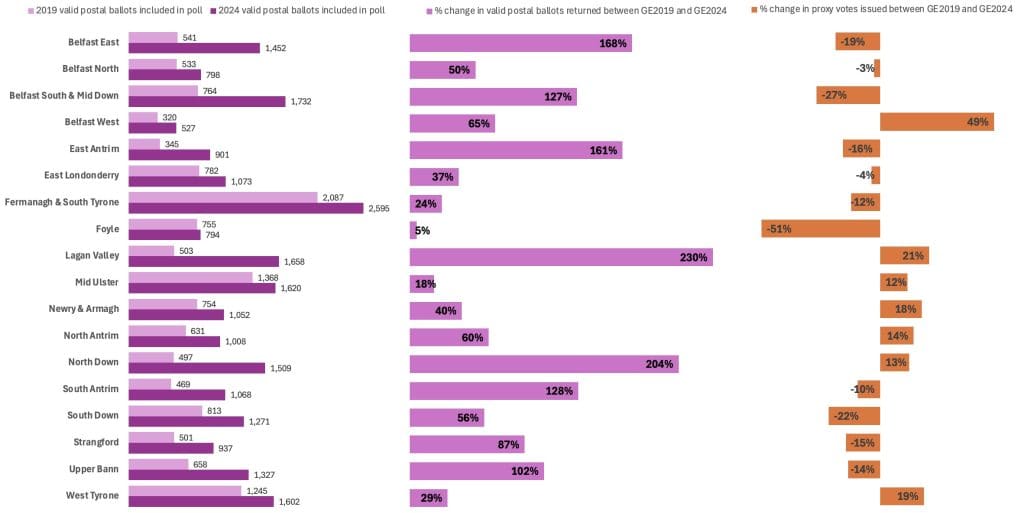With the 4 July General Election being called during school holidays in Northern Ireland (and much of Scotland), was there an increase in the number of postal ballots and proxy votes issued?
Yes and no.
The statistics for 2024 have been published by the Electoral Office for Northern Ireland this afternoon. (link to 2019 stats)
Postal Ballots
The number of postal ballots issued jumped from 16,993 in GE2019 to 25,747 in GE2024. That’s a 52% increase.
Not every postal ballot that is issued is returned. 16% were not used in 2019, but that figure declined to just 9% this year.
Some of the postal ballots that are returned are rejected. Fields may be missing on the form, or signatures don’t match, etc. There was a higher rate of return, and a higher rate of being included in the poll in 2024 than 2019 (89% vs 80%).
While 13,566 postal ballots were included in the count in 2019, 22,924 were included this year, an increase of 69%.
Looking across the constituencies, the largest increases were recorded in Lagan Valley (230% increase in postal ballort returned and accepted into the poll), North Down (204%), Belfast East (168%), East Antrim (161%). There was an increase in the number of postal ballots making it into the poll in all 18 constituencies. The smallest rise was in Foyle (5%) where there was a drop in the number issued, but a rise in the number returned.
Belfast West remained the constituency with the fewest postal ballots issued (just 612 in 2024) and making it into the 2024 poll (527).
Proxy votes
The number of proxy votes issued was down overall (8,820 issued across Northern Ireland in 2019, only 8627 in 2024). The number of proxies issued went down in all but seven constituencies (Belfast West up 49%, Lagan Valley, Mid Ulster, Newry & Armagh, North Antrim, North Down, and West Tyrone).
Fermanagh & South Tyrone continued to have by far the largest number of proxies issued (1,354, down 12% on 2019 in which the constituency had the highest percentage of proxy votes issued of any of the 650 UK constituencies).
The largest drop in proxy votes issued was in Foyle which dropped 51% from 905 in 2019 to 443 in 2024.
There are no figures for the number of proxy votes that are used.
How does Northern Ireland differ from England, Scotland and Wales?
Overall figures for 2024 to allow comparison across the UK are not yet available.
Figures from the Electoral Commission for the 2019 General Election show that turnout in Northern Ireland (62.1%) was the lowest of their 12 UK regions (NI, Scotland, Wales, North East, North West, Yorkshire and the Humber, East Midlands, West Midlands, East of England, London, South East, South West). The overall UK turnout in 2019 was 68%.
The percentage of rejected ballots at the count was highest in Northern Ireland (0.53% vs UK rate of 0.37%).
The level of postal voting in Northern Ireland was 11 times lower (1.3%) than the next lowest UK region (West Midlands 14.7%), and 13 times lower than the UK figure (17.6%).
The level of proxy votes being issued in Northern Ireland (0.68%) was above the UK average (0.58%).
If the practice of voting by postal ballot in Northern Ireland (1.3% in 2019) rose to levels similar to England (17.6%), Scotland (18.1%) and Wales (18.1%), out turnout might not look so low. However, with legislation and processes diverging between Northern Ireland and Great Britain, this is not likely to happen quickly until it is possible to request postal voting ‘on demand’.
Alan Meban. Tweets as @alaninbelfast. Blogs about cinema and theatre over at Alan in Belfast. A freelancer who writes about, reports from, live-tweets and live-streams civic, academic and political events and conferences. He delivers social media training/coaching; produces podcasts and radio programmes; is a FactCheckNI director; a member of Ofcom’s Advisory Committee for Northern Ireland; and a member of the Corrymeela Community.
Discover more from Slugger O’Toole
Subscribe to get the latest posts sent to your email.




